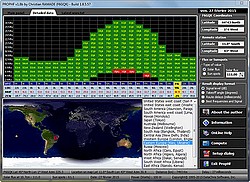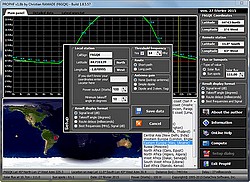
This program predicts the most likely operating frequencies and signal levels for high frequency (shortwave) radio propagation paths on specified days of the year and hours of the day. It is most useful for paths between 250 km and 6000 km, but can be used with reduced accuracy for paths shorter or longer than this.
High frequency radio propagation between approximately 3 Mhz and 30 Mhz is dominated by two ionospheric layers, the E layer at a height of about 110 km above the Earth, and the F layer, which varies between 250 km and 350 km, depending on the time of day, season of year and solar activity. For the medium range paths for which this program is intended, the dominant mode is via the F-layer, although the program does consider the E-layer in order to determine path loss. The success of each path is determined by the transmitter power, receiver sensitivity, propagation path loss and ambient noise. Especially at the lower frequencies during the summer months, the ambient noise is dominated by electrical discharges due to lightning in local and distant thunderstorms. This program computes the thermal component of the ambient noise, but does not include the electrical component, which must be estimated from experience and seasonal conditions.

Radio propagation predictions require knowledge of solar activity, which is compiled from daily observations of the Sun and usually expressed as the 10-cm solar flux, which has largely replaced the use of sunspot counts for this purpose. The accuracy of the program depends on the accuracy in predicting this number, which is usually averaged over some period of days, weeks or months. The flux for the preceding day is broadcast by WWV/WWVH each hour and are also available by telephone [NIS90]. Predictions for one or more months in advance are also available in periodicals such as QST. The program uses a routine Minimuf 3.5 developed by the U.S. Navy and used to predict the MUF given the predicted flux, day of the year, hour of the day and geographic coordinates of the transmitter and receiver. This routine is reasonably accurate for the purposes here, with a claimed RMS error of 3.8 MHz, but much smaller and less complex than the programs used by major shortwave broadcasting organizations, such as the Voice of America.
In order to interpret the data produced by this program, it is useful to consider how it is produced. Given the MUF as predicted, the program constructs candidate ray geometries over the shorter of the two great-circle paths between the transmitter and receiver. The program can also do this for the longer of these paths, but the accuracy is questionable at best. The program constructs first the minimum-hop path constrained by the minimum takeoff angle; that is, the minimum angle between the local horizon at the great-circle azimuth and transmitted ray, which is a property of the antenna and local topography. The default minimum angle is 10 degrees, but this can be changed by an option. The program then constructs paths for the next two higher-number hops, in order to assess multipath conditions. For all three paths the program computes the minimum F-layer MUF, maximum E-layer MUF and ionospheric absorption factor.
Using these data and the transmitter power, antenna gain and frequencies specified, the program determines for each frequency whether a geometric ray path is possible and, if so, computes the path loss and delay. A path is possible only when the frequency is below the F-layer MUF and the signal level is greater than the thermal noise (2500 Hz at 290 K). The program output is in the form of a table, with one entry for each hour of the UTC day, as described elsewhere.
View/Sign my Guestbook
Voir/Signer mon livre d'or

